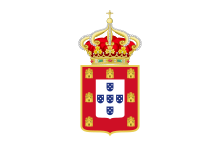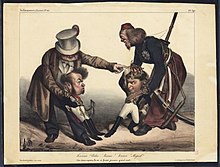Miguelista War
In Portuguese history, the Miguelistenkrieg (also war of the two brothers , Portuguese a guerra dos dois irmãos ) describes a civil war that lasted from 1832 to 1834 between the supporters of King Michael I and the supporters of his brother, ex-King Peter IV and his Daughter Maria II.
King Michael is called Dom Miguel in Portuguese, so his followers were called miguelistas , miguelists , which gave the conflict its name.
Causes of the war and developments up to the beginning of the war
Since the Napoleonic occupation of Portugal in 1807, the ideals of the French Revolution had also established themselves in Portugal. The political current of the liberals had formed, who advocated a constitutional monarchy . Manuel Fernandes Tomás was one of their most outstanding representatives. With the liberal revolution of 1820, liberalism had its first great success in the history of the country. In 1821 the first constitution of Portugal was passed by a constituent assembly, which was then passed by King John VI. was also put into effect.
However, there was some resistance to liberalism from reactionary and conservative forces who wanted to cling to the old absolutist system of government. These called themselves absolutists ( absolutistas ). The majority of the Catholic Church was also opposed to the liberal movement, as the Liberals also wanted to abolish the special rights of the Church and generally advocated anti-clerical politics.
The contrast between liberals and absolutists that shaped Portuguese domestic politics at the time also ran right through the royal family. While King John VI. Wanted to keep his oath on the constitution of 1821, that is, more in the liberal camp, his wife, Queen Charlotte Johanna and his younger son, Prince Michael, were supporters of the absolutists. As early as 1824, the Queen and Prince Michael tried to oust the king and reintroduce absolutism, but this failed. Prince Michael then had to go into exile in Austria . There he got into the circle of the reactionary politician Prince Metternich , which reinforced his absolutist views.
In the course of the events of 1824, the constitution was also revoked. The Liberals therefore called for a return to constitutionalism. In 1826 the new king, Peter IV , complied with these demands and gave the country a new constitution, the so-called Charter . Although this was much more conservative than the constitution of 1821, it provoked the protests of the absolutists, who wanted to forego a constitution altogether.
Peter IV was, when he was still crown prince, from his father Johann VI. left behind in Brazil to rule that land as regent. On September 7, 1822, he had proclaimed Brazilian independence and made himself Emperor Peter I of Brazil. Johann VI died in 1826. of Portugal, so that his son Peter I of Brazil also ascended the Portuguese throne as Peter IV of Portugal. But it soon became obvious that it was no longer possible to rule both empires at the same time. Since Peter did not want to do without Brazil, he abdicated on May 5, 1826 after only two months of reign as Portuguese king in favor of his underage daughter Maria II. Peter wanted to bring the two warring lines of the House of Braganza back together and had therefore planned that his brother Michael should marry his daughter Maria. Together they should then rule Portugal. Michael was to act as regent during Mary's minority. Michael returned to Portugal from his exile in Vienna.
It soon became apparent that he had other plans. He convened a traditional meeting of the estates, this dethroned Maria II and proclaimed Michael king in 1828. Michael had allied himself with the reactionary forces of the country, revoked his brother's constitutional charter and ruled as the last absolutist king of Portugal.
However, Peter was not ready to accept his brother's breach of trust. In addition to the Portuguese entanglements, there were domestic political difficulties in Brazil. Finally, on April 7, 1831, he abdicated as Emperor of Brazil in order to be able to devote himself entirely to the Portuguese problem. He reassumed the title of Duke of Braganza , declared himself regent of his underage daughter Maria (whom he still considered the legitimate queen of the country) and went to Europe to take up the fight against his brother.
So it was the Miguelistenkrieg
- both a civil war between absolutists (who supported Michael) and liberals (who sided with Peter and Maria II)
- like a dynastic battle within the house of Braganza between the two brothers Peter and Michael.
Course of the war
At the beginning of the war things did not look good for Peter and the Liberal cause. Michael had brought all of Portugal (with the exception of the Azores island of Terceira ) under his control and ruled with a hard hand. Most of his liberal opponents were in exile , scattered across half of Europe (with a focus on London , Paris and Brussels ) and Brazil, and also at odds with one another. Michael also favored the general political climate in Europe, shaped by the Holy Alliance and its reactionary politics. The July liberal revolution of 1830 in France led to a first turnaround, which gave courage to the liberal movements in Europe. The new French king, Ludwig Philipp, supported Peter, and so Peter went to Paris after his abdication in Brazil.
Off the Azores island of Terceira, the later Duke of Terceira , a loyal supporter of the Liberals and Peters, succeeded in defeating a Miguelist fleet in the battle of Vila da Praia (1829), so that the island remained the only part of Portugal outside of Michael's sphere of influence. In the next few years Terceira managed to conquer the other islands of the archipelago. This allowed Peter to go to the Azores on March 3, 1832, and so to step back on Portuguese soil. With a liberal army raised there, he embarked for Portugal and entered mainland Portugal on June 8, 1832 near Pampelido near Porto . He brought the Liberal General João Carlos de Saldanha Oliveira e Daun , Duke of Saldanha, who was in exile in Britain, back to Portugal and made him Commander in Chief of the Liberal Army.
The Liberals succeeded in conquering Porto, which was then besieged by Michael’s troops under General Lemos . When this siege was unsuccessful, Michael left Lisbon and went to Porto to join his troops. Taking advantage of the absence of the King of Lisbon, a second army under the command of the Duke of Terceira and with the support of British naval forces succeeded in conquering Lisbon in 1833. With that, the two most important cities of the country, Lisbon and Porto, were in the hands of the constitutionalists. Peter had his daughter, now fourteen years old Maria II, come from Paris to Lisbon, where she was enthusiastically received.
In this situation Michael made a serious political mistake. In Spain , King Ferdinand VII had appointed his daughter, who later became Queen Elisabeth (Isabella) II, as his successor, in breach of the previous Salian right of succession to the throne, which only provided for male succession. Ferdinand's brother Karl (Don Carlos), who was ousted from the line of succession by the new regulation (see First Carlist War ), rebelled. Michael now allied himself with Karl, whom he received with all honors in Portugal, and thus made King Ferdinand VII an enemy. The Spanish king recognized Maria II as the rightful queen of Portugal and allied with the liberal counter-government of Portugal, the English and the French to form a quadruple alliance .
After the decisive defeats at Almoster on February 18, 1834 and at Asseiceira on May 16, 1834, the last meeting occurred in Évoramonte . Michael's troops were defeated on May 26, 1834 by Terceira and Minister of War Saldanha, and Michael had to go into exile again, to Italy . Peter initially announced an amnesty, which provided that Michael received the title of royal infante of Portugal and should receive an appropriate apanage in exile. However, this arrangement led to a revolt against Peter. The latter, already marked by serious illness, withdrew to the palace of Queluz, where he died a short time later. A new Cortes met in Lisbon to elect the Duke of Palmela as Prime Minister. Two important laws were passed in the Cortes. On the one hand, Maria II was declared of legal age so that she could govern independently in the future. On the other hand, the regulation with which Michael was promised an appanage was revoked. As soon as Michael found out about this, he in turn revoked his abdication from his exile in Italy and made it clear that he continued to regard himself as the legitimate king. Michael finally died in Bronnbach in Baden without ever having renounced his claims to the Portuguese throne.
meaning
With Peter's victory, constitutionalism was finally anchored in Portugal. It is true that the liberals quickly split into a more conservative wing (the Cartists ) and a more radical wing (the Setembrists ), which from 1846 faced each other in a civil war. The question at stake was what the country's constitution should look like. The fact that Portugal should have a constitution, on the other hand, has not been called into question since the end of the Miguelist War. There has been no return to absolutism since the end of the war in Portugal.
See also
literature
- Hipólito de la Torre Gómez, António Pedro Vicente, España-Portugal: estudios de historia contemporánea , Madrid, 1998, ISBN 978-84-7738-616-2
- Paul Siebertz, Dom Miguel ea sua época - A verdadeira História da Guerra Civi , Mem Martins, ACTIC, 1986.
- Francisco Pina Manique, A Causa de D. Miguel , Lisbon, Caleidoscópio, 2007
- Simão José da Luz Soriano, História da Guerra Civil e do Estabelecimento do Regime Parliamentarians in Portugal , 1866–90


